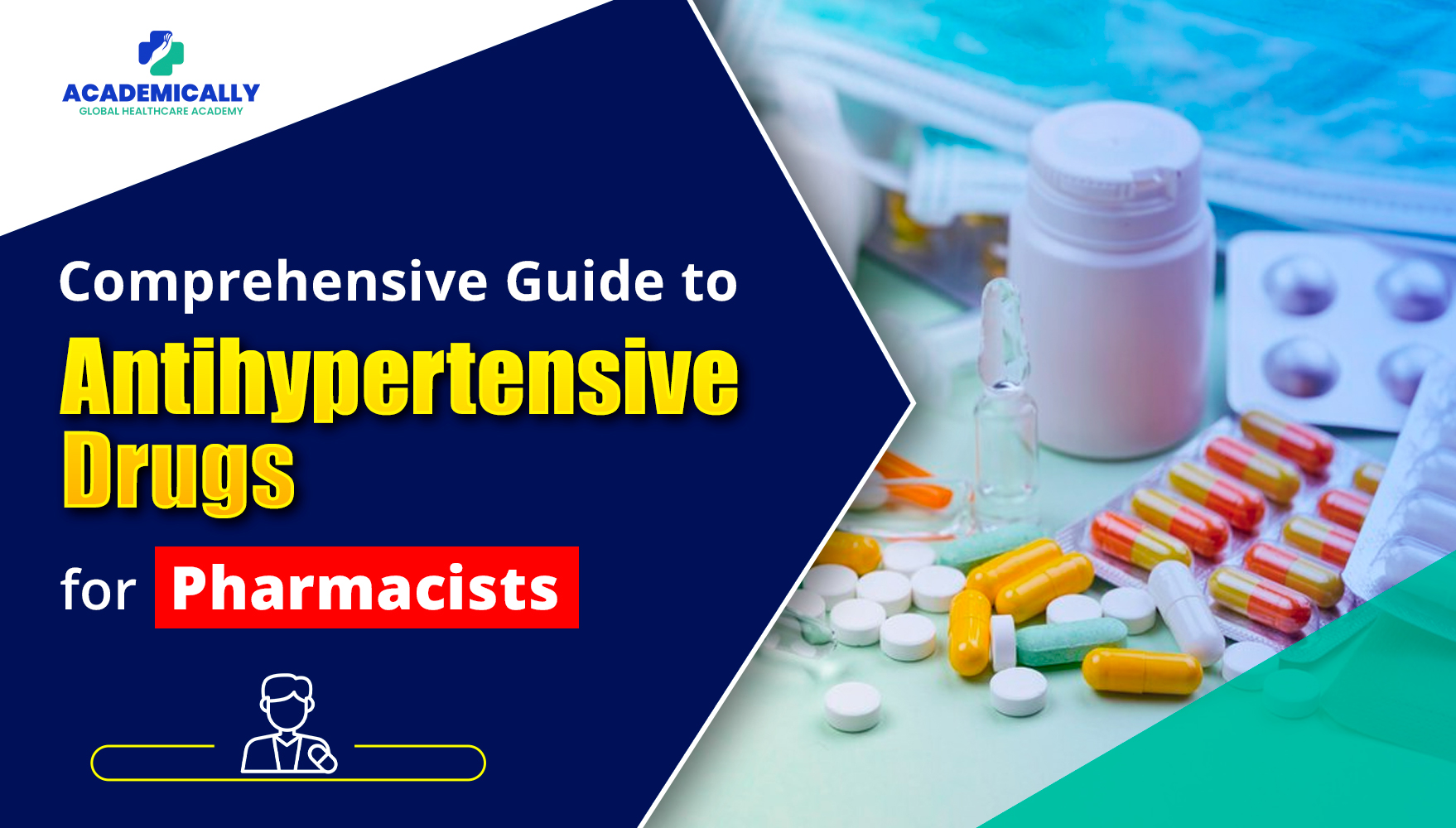Hypertension is a common cardiovascular disease affecting the worldwide population. A persistent and sustained high blood pressure has damaging effects on the heart, brain, kidneys and eyes. Hypertension could be:
- Primary or essential hypertension: It is the most common type. There is no specific underlying cause.
- Secondary hypertension: It can be due to renal, vascular, endocrine disorders, etc.
As a leading cause of premature death worldwide, hypertension necessitates urgent attention and effective management strategies. One of the global health targets for noncommunicable diseases is to reduce the prevalence of hypertension by 33% between 2010 and 2030.
In this blog, we discuss the classification of antihypertensive drugs and its role in managing and mitigating the risks associated with hypertension.
Classification of Antihypertensive Drugs
1. Angiotensin converting enzyme (ACE) inhibitors: Captopril, enalapril lisinopril, perindopril, ramipril, benazepril, fosinopril.
2. Angiotensin II receptor blockers (ARBs): Losartan, candesartan, irbesartan, valsartan, telmisartan, olmesartan.
3. Direct renin inhibitor: Aliskiren.
4. Calcium channel blockers (CCBs): Diltiazem, verapamil, nifedipine, amlodipine, nicardipine, isradipine, felodipine, nitrendipine.
5. Diuretics
(a) Thiazides and related agents: Hydrochlorothiazide, chlorthalidone, indapamide. (b) Loop diuretics: Furosemide, bumetanide, torsemide.
(c) Potassium-sparing diuretics: Amiloride, triamterene, spironolactone, eplerenone.
6. Sympatholytic agents
(a) Centrally acting sympatholytics: Clonidine, alpha-methyldopa.
(b) Beta-Adrenergic blockers: Atenolol, metoprolol, esmolol, propranolol, betaxolol, cartel or, propranolol, timolol.
(c) Beta-Adrenergic blockers with ad al &-blocking activity: Labetalol, carvedilol.
smolol, betaxolol, carvedilol.
(d) Alpha-Adrenergic blockers: - Selective: Prazosin, terazosin, doxazosin. - Nonselective: Phenoxybenzamine, phentolamine.
(e) Ganglion blocker: Trimethaphan.
(f) Neurone blocker: Reserpine.
7. Vasodilators
(a) Arteriolar-dilators: Hydralazine, minoxidil, diazoxide, fenoldopam.
(b) Primarily venodilator: Nitroglycerin.
(c) Arteriolar and venodilator: Sodium nitroprusside.
Treatment of Hypertension
1. Non-pharmacological approaches helpful to control hypertension are weight reduction, sodium restriction, alcohol restriction, exercise, mental relaxation, cessation of smoking and consumption of potassium rich diet.
2. Drug treatment: Selection of antihypertensive drugs in individual patients depends on:
(i) comorbidity,
(ii) associated complications,
(iii) age,
(iv) sex,
(v) cost of the drug and
(vi) concomitant drugs.
- Preferred drugs for initial treatment of hypertension: ACE inhibitors, ARBs, CCBs and thiazides.
- Therapy usually started with a single agent.
Dosage and indication of hypertensive drugs
| Drug | Dosage | Indications |
| Hydrochlorothiazide | 12.5-25 mg OD oral | Mild Hypertension |
| Chlorthalidone | 12.5-25 mg OD oral | Mild Hypertension |
| Captopril | 12.5-75 mg BD oral | Mild to severe hypertension especially in diabetes |
| Enalapril | 2.5-40 mg OD oral | Mild to severe hypertension especially in diabetes |
| Lisinopril | 5-40 mg OD oral | Mild to severe hypertension especially in diabetes |
| Ramipril | 1.25 - 20 mg OD oral | Mild to severe hypertension especially in diabetes |
| Losartan | 25-50 mg OD or BD oral | Mild to severe hypertension especially in diabetes |
| Propranolol | 10-120 mg, BDor QID oral | Mild to moderate hypertension |
| Atenolol | 25-100 mg OD oral | Mild to moderate hypertension |
| Prazosin | 1-10 mg BD oral | Mild to moderate hypertension |
| Clonidine | 0.05-0.6 mg BD | Mild to moderate hypertension |
| Sodium nitroprusside | 0.25-1.5 mcg/kg/minute i.v. infusion in 5% dextrose | Hypertensive emergencies (hypertensive crisis) |
| Nifedipine SR | 30-90 mg OD oral | Mild to moderate hypertension |
| Amlodipine | 2.5-10 mg OD oral | Mild to moderate hypertension |
| Alpha-Methyldopa | 250 mg-2 g/day oral | Hypertension during pregnancy |
Commonly used drugs for hypertension associated with the following conditions
| Angina/Post MI | Beta-Blockers |
Congestive cardiac failure/Left ventricular failure | ACE inhibitors, loop diuretics and ARBs |
| Diabetes mellitus and diabetic nephropathy | ACE inhibitors, ARBs, CCBs |
| Bronchial asthma/COPD | Calcium channel blockers (CCBs) |
| Hypertensive emergencies | Sodium nitroprusside, labetalol, nitroglycerin |
| Benign prostatic hyperplasia (BPH) | Selective a1-blocker |
| Pregnancy | a-Methyldopa, hydralazine, labetolol |
- Combination therapy is used in patients who do not respond to a single drug, and can be used as initial therapy in patients with high BP.
- Combination therapy: ACE inhibitors/ARBs with either thiazides/DHDs. If response is not satisfactory other antihypertensives can be added, eg. thiazides/DHPs with beta-blockers. ACE inhibitors are not to be combined withARBs.
Conclusion
Antihypertensive drugs is an important topic for many healthcare professionals, with numerous questions from this topic frequently appearing in competitive exams like the KAPS.
For a thorough understanding of antihypertensive drugs and access to key exam questions, join Academically’s KAPS Exam Preparation Course. Our curriculum is tailored to help pharmacists pass the exam on their first attempt.

To learn more about the course and the exam, fill out this form to receive expert guidance.


